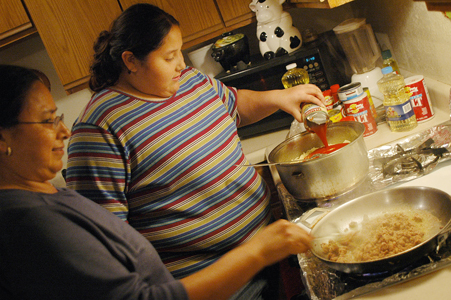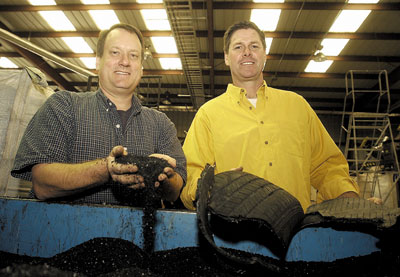
Without a local food pantry, one mother would be left with an
empty table
Maria Arias shares her Hollister home with three of her four
children and two brothers. The living room has mixed-matched
furniture, a dark carpet and dark faux-wood paneling that make it
seem dimmer than it is. On the walls, mixed in with family
portraits and her children’s class pictures, Arias pointed out half
a dozen photographs of volunteering with Community Pantry.
Without a local food pantry, one mother would be left with an empty table
Maria Arias shares her Hollister home with three of her four children and two brothers. The living room has mixed-matched furniture, a dark carpet and dark faux-wood paneling that make it seem dimmer than it is. On the walls, mixed in with family portraits and her children’s class pictures, Arias pointed out half a dozen photographs of volunteering with Community Pantry.
“I like to help people and explain what the program is about,” Arias said in her native Spanish through a translator. “I volunteer more since I’m not working right now.”
The pantry recognized Arias for her dedication to volunteering in 2003 when they acknowledged her as a volunteer of the year. Her framed certificate hangs on the wall near her 13-year-old daughter’s student of the month award.
“She [volunteers] 20 hours a week instead of two,” said Mary Anne Hughes, the executive director of Community Pantry. “She works each week at distribution. Here she is helpful at the warehouse. She does intake interviews and helps in the office.”
But Arias is not just a volunteer at the local pantry – her family is one of the 1,500 members that rely on the program for food each week. Members pay a small yearly fee of $15-40 and volunteer at the pantry for the food they receive.
Arias joined Community Pantry in 1999 when she learned about the organization through outreach to residents at a mobile-home park.
“They said they help people who don’t have a lot of money for food,” Arias said.
Each week after she spends the day packing bags and handing out groceries, the middle-aged mom with a dark brown ponytail and a flowered nametag, takes two bags home for herself and three of her children.
Arias held her head high when she talked about the struggles her family has faced, speaking a few words of English in between a stream of Spanish, using her teenage daughter, Daniela, as her translator.
The family has always struggled financially, but for the last three years the burden of providing for her family has fallen solely on Arias.
“My mom is separated from my dad and he used to work,” Daniela said.
The family hasn’t heard from him since he left, neither have they received any money to help them.
“He’s in Mexico or maybe somewhere in California,” Daniela said, unsure of his whereabouts.
With no income coming in, Arias relies on her brothers and her oldest son, Victor, to pay the rent and utilities for their home.
“Now we are like that again,” Arias said, recalling the financial hardships that first brought them to Community Pantry.
The family receives two bags of food a week, but the foods vary depending on the donations received at Community Pantry and the food purchased by Hughes. The mix includes bread products, fresh produce, beans or rice, and canned foods. Once a month they receive ground beef or chicken from the pantry provided by the United States Department of Agriculture, but Hughes provides other protein sources throughout the month.
From the foods she receives, Arias makes fried potatoes, salsa and beans or tuna salad. The food the pantry offers is healthy, Arias said. Recently her family received fresh artichokes, salad greens and bananas. When she cooks she prefers baking to frying foods and she uses little vegetable oil when cooking. So far no one in her family has been diagnosed with an illness cause by poor nutrition such as diabetes, but struggles with such diseases are common for families with little money to spend on food.
“We’ve just started working on the nutritional value of the bags,” Hughes said. “Something that came up at a conference [I attended] was looking at products that offer calcium, folates and vitamin C. If you have a choice between apple juice and orange juice, it’s a no brainer. Orange juice offers more benefits.”
In the meantime, Arias makes do with the bags of food she receives.
She cooks meals each evening for her family in the small kitchen of her home. The space offers few countertops. She points out several items on the counter that came from the pantry – canned tomato sauce, canned yams, and a bag of pinto beans. A kitchen table along the wall has fewer chairs than there are family members. Her pots and pans are worn, silver-colored utensils without a non-stick coating.
Community Pantry gave the family much of the furniture in the home, including the mixed-match sofas in the living room.
One evening last week Arias cooked Daniela’s favorite meal – spaghetti with meat sauce. Arias boiled the spaghetti noodles and mixed them with butter and canned tomato sauce after it drained. She sauteed the hamburger meat before mixing it in with the pasta. All of the ingredients came from the pantry.
“Some things that [the pantry] doesn’t have right now are tomatoes, onions and peppers,” Arias said. “These are things that we buy. Sometimes we buy milk or paper towels, toilet paper and soap.”
The family spends about $10 a week for food items they don’t receive from the pantry. There aren’t any foods she misses having that the family can’t afford, Daniela said. She even gets her favorite fruit sometimes, though it isn’t fresh.
“I like pineapple,” she said. “We get it in fruit cocktail cans.”
Daniela, who is finishing up her last year in middle school and looks forward to attending San Benito High School next fall, receives free lunch at school.
“Mostly all the kids have it,” she said. “So I’m not embarrassed.”
Like many families, the summer months when two of her children are out of school require Arias to provide more food in the house. But since she usually has seasonal work during the summer, the family manages.
While the pantry is meant to be a supplemental food program to serve local needs during emergencies, such as a sudden loss of employment, more and more members are sticking around for more than a few months. The pantry doesn’t limit the time people can remain members.
“Our economy has gotten to a place where there are more people who can’t consistently come up with the money to meet their needs,” Hughes said. “There is a reduction in seasonal work…the fields are much more mechanized so the number of people needed in the field is reduced.”
Arias works hard when she can find work, often leaving her family from 11 p.m. to 7 a.m. for the late shift at a local cannery or at Christopher Ranch. She has been out of work since September, but she should be able to find work in May or June when agricultural companies start hiring seasonal employees. As she looks for the next job, she said she hopes this time it will be long-term.
“I felt sad a lot of times because I didn’t have food to give to my children,” Arias said.
She expressed gratitude to the employees of Community Pantry including Hughes, Lourdes Cordova, the assistant executive director of the pantry, and Martha Juarez, an administrative assistant.
“I am really thankful to Mary Anne, Lulu and Martha for helping me so much,” she said.
Despite their own hardship, Arias and Daniela remain aware that they are more fortunate than some of the people they help at the pantry.
“I’m proud to help people,” Daniela said, who sometimes volunteers with her mom. “There are a lot of homeless people that need our help. I wish they could have a house like us.”
Ways to donate money, food or time:
San Benito County
Community Pantry, www.communitypantry.com, 831-637-0340
Second Harvest Food Bank of Santa Cruz and San Benito Counties, www.thefoodbank.org, 831-722-7110
Santa Clara County
St. Joseph’s Family Center, www.stjosephsgilroy.org, 408-842-6662
Second Harvest Food Bank of Santa Clara and San Mateo Counties, www.2ndharvest.net, 866-234-3663
SEE RELATED STORY:
SEE RELATED STORY:
Plenty of produce, but little storage









